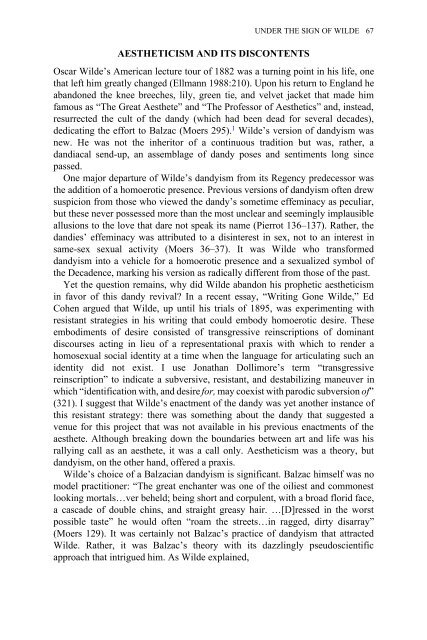Edited by Moe Meyer - Get a Free Blog
Edited by Moe Meyer - Get a Free Blog
Edited by Moe Meyer - Get a Free Blog
You also want an ePaper? Increase the reach of your titles
YUMPU automatically turns print PDFs into web optimized ePapers that Google loves.
AESTHETICISM AND ITS DISCONTENTS<br />
UNDER THE SIGN OF WILDE 67<br />
Oscar Wilde’s American lecture tour of 1882 was a turning point in his life, one<br />
that left him greatly changed (Ellmann 1988:210). Upon his return to England he<br />
abandoned the knee breeches, lily, green tie, and velvet jacket that made him<br />
famous as “The Great Aesthete” and “The Professor of Aesthetics” and, instead,<br />
resurrected the cult of the dandy (which had been dead for several decades),<br />
dedicating the effort to Balzac (<strong>Moe</strong>rs 295). 1 Wilde’s version of dandyism was<br />
new. He was not the inheritor of a continuous tradition but was, rather, a<br />
dandiacal send-up, an assemblage of dandy poses and sentiments long since<br />
passed.<br />
One major departure of Wilde’s dandyism from its Regency predecessor was<br />
the addition of a homoerotic presence. Previous versions of dandyism often drew<br />
suspicion from those who viewed the dandy’s sometime effeminacy as peculiar,<br />
but these never possessed more than the most unclear and seemingly implausible<br />
allusions to the love that dare not speak its name (Pierrot 136–137). Rather, the<br />
dandies’ effeminacy was attributed to a disinterest in sex, not to an interest in<br />
same-sex sexual activity (<strong>Moe</strong>rs 36–37). It was Wilde who transformed<br />
dandyism into a vehicle for a homoerotic presence and a sexualized symbol of<br />
the Decadence, marking his version as radically different from those of the past.<br />
Yet the question remains, why did Wilde abandon his prophetic aestheticism<br />
in favor of this dandy revival? In a recent essay, “Writing Gone Wilde,” Ed<br />
Cohen argued that Wilde, up until his trials of 1895, was experimenting with<br />
resistant strategies in his writing that could embody homoerotic desire. These<br />
embodiments of desire consisted of transgressive reinscriptions of dominant<br />
discourses acting in lieu of a representational praxis with which to render a<br />
homosexual social identity at a time when the language for articulating such an<br />
identity did not exist. I use Jonathan Dollimore’s term “transgressive<br />
reinscription” to indicate a subversive, resistant, and destabilizing maneuver in<br />
which “identification with, and desire for, may coexist with parodic subversion of”<br />
(321). I suggest that Wilde’s enactment of the dandy was yet another instance of<br />
this resistant strategy: there was something about the dandy that suggested a<br />
venue for this project that was not available in his previous enactments of the<br />
aesthete. Although breaking down the boundaries between art and life was his<br />
rallying call as an aesthete, it was a call only. Aestheticism was a theory, but<br />
dandyism, on the other hand, offered a praxis.<br />
Wilde’s choice of a Balzacian dandyism is significant. Balzac himself was no<br />
model practitioner: “The great enchanter was one of the oiliest and commonest<br />
looking mortals…ver beheld; being short and corpulent, with a broad florid face,<br />
a cascade of double chins, and straight greasy hair. …[D]ressed in the worst<br />
possible taste” he would often “roam the streets…in ragged, dirty disarray”<br />
(<strong>Moe</strong>rs 129). It was certainly not Balzac’s practice of dandyism that attracted<br />
Wilde. Rather, it was Balzac’s theory with its dazzlingly pseudoscientific<br />
approach that intrigued him. As Wilde explained,


